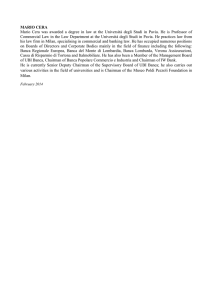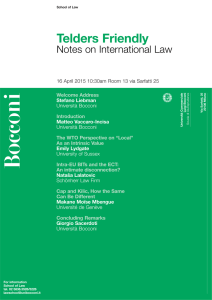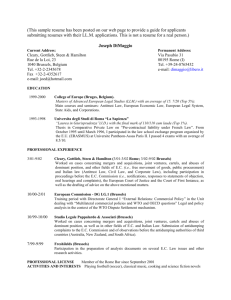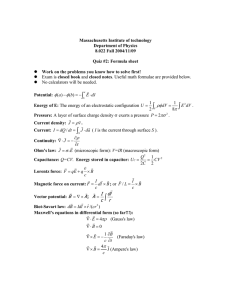Ampere's Law
advertisement
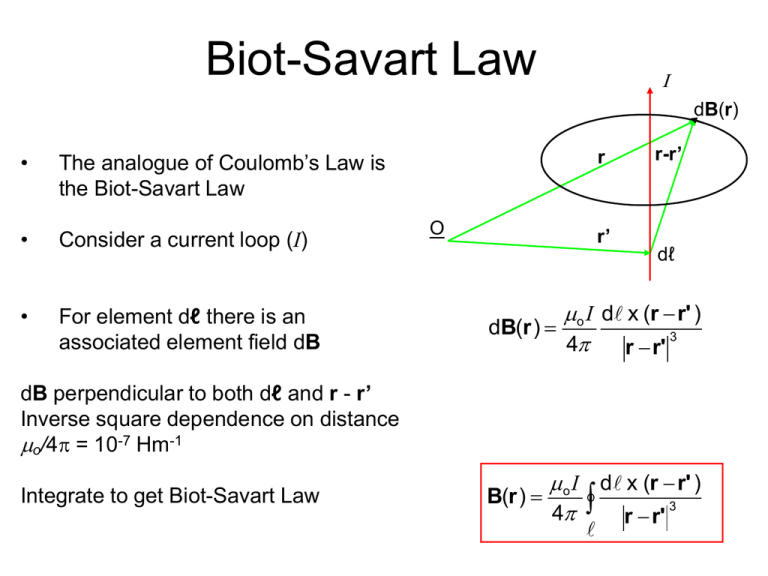
Biot-Savart Law I dB(r) • The analogue of Coulomb’s Law is the Biot-Savart Law • Consider a current loop (I) • For element dℓ there is an associated element field dB r O r-r’ r’ dℓ dB(r ) o Ι d x (r r' ) 3 4p r r' dB perpendicular to both dℓ and r - r’ Inverse square dependence on distance o/4p = 10-7 Hm-1 Integrate to get Biot-Savart Law o Ι d x (r r' ) B(r ) 4p r r' 3 Biot-Savart Law examples (1) Infinite straight conductor dℓ and r, r’ in the page dB is into the page B forms concentric circles about the conductor o I d x (r r' ) B(r ) 4p r r' 3 d x (r r' ) d r r' sinq nˆ 2 r r' r 2 z 2 q p / 2 a I d x (r r' ) dℓ q r r' r’ z O r - r’ r a dB B 3 sinq cosa d r r' sinq r r' 3 r nˆ r 2 r o I r dz B nˆ 3/2 2 2 4p r z r r dz 2 z2 3/2 2 r B o I ˆ n 2pr z2 1/2 r dz 2 z 2 3/2 nˆ Biot-Savart Law examples (2) Axial field of circular loop dℓ Loop perpendicular to page, radius a q dℓ out of page at top and r, r’ in the page On-axis element dB is in the page, perpendicular to r - r’, at q to axis. r’ I a r - r’ r z dB || n q dBz Magnitude of element dB dB o I d x r - r ' o I d ˆ o I d n dB cosq z 3 2 2 4p 4p r - r ' 4p r - r ' r - r' a a cosq r - r' a2 z2 1/2 Integrating around loop, only z-component of dB contributes net result On-axis field of circular loop dℓ o I Bon axis dB z o I 4p r - r ' 4p r - r ' 2 cosq 2p a 2 Introduce axial distance z, where |r-r’|2 = a2 + z2 r - r’ cosq d o Ia 2 r - r' Bonaxis I 2 a 3 o I a 2 2a z 2 2 limiting cases B z 0 on axis o I 2a and B z a on axis r’ o Ia2 2z3 2 3 2 r z dB q dBz Magnetic dipole moment The off-axis field of circular loop is much more complex. For z >> a (only) it is identical to that of the electric point dipole E p 4p or 3 2 cosq rˆ sinq qˆ p q+ q- om 2 cosq rˆ sinq qˆ 3 4p r where m p a 2 I or m p a 2 I zˆ B p a 2 area enclosed by current loop m = current times area vs p = charge times distance m = magnetic dipole moment m q r I Current I and current density j Current density j(r ) = (r ) v(r ) Suppose current is composed of point charges j(r) q i (r - ri ) v i i Integrate current over some volume, V, say A d𝓁 where A is cross-section area of wire d𝓁 is element of length of wire j(r).nˆ dr q (r - r ) v .nˆ dr q i V i V i i i v i . nˆ Id i in V n is a unit vector parallel to the current direction Current is commonly treated as continuous (j(r)), but is actually composed of point particles Continuity Equation Rate of charge entering xz face at y = 0: jy=0DxDz Cm-2s-1 m2 = Cs-1 Rate of charge leaving xz face at y = Dy: jy=DyDxDz = (jy=0 + ∂jy/∂y Dy) DxDz Net rate of charge entering cube via xz faces: (jy=0 - jy=Dy ) DxDz = -∂jy/∂y DxDyDz Rate of charge entering cube via all faces: z jy=0 Dz Dy Dx x -(∂jx/∂x + ∂jy/∂y + ∂jz/∂z) DxDyDz = dQencl/dt = lim (DxDyDz)→0 Qencl /(DxDyDz) jy=Dy y . j + d /dt = 0 For steady currents d /dt = 0 (Magnetostatics) and . j = 0 Applies to other j’s (heat, fluid, etc) Conservation of charge, energy, mass, .. Ampere’s Law I dB(r) Replace I d𝓁 by j(r’) dr’ in Biot-Savart law j(r' ) x (r r' ) dB(r ) o dr' 3 4p r r' r 1 r r' - r r' r r' 3 dB(r ) O o j(r' ) x dr' 4p r r' o j(r' ) B(r ) x dr' 4p r r' r’ dℓ o 1 j(r' ) x dr' 4p r r' o B(r ) 4p r-r’ j(r' ) x (r r' ) r r' 3 See Homework Problems II for intermediate steps E(r ) dr' E(r ) 1 (r' ) 4po 1 (r' ) (r r' ) 4po r r' r r' 3 dr' - (r ) dr' Ampere’s Law Evaluate Div and Curl of B(r) NB ∇ acts on functions of r only, ∇’ acts on functions of r’ o j(r' ) B(r ) x dr' 4p r r' o j(r' ) .B(r ) . x dr' . x f(r ) 0 4p r r' o j(r' ) x B(r ) x x dr' o j(r ) term containing . j(r' ) 4p r r' .B 0 Absence of magnetic monopoles (generally valid) x B o j Ampere’s Law (limited to magnetostatics (∇.j = 0)) Ampere’s Law Can B(r) be expressed in terms of a potential? Yes! B(r ) o j(r' ) x dr' 4p r r' o x A(r ) 4p j(r' ) A(r ) o dr' 4p r r' B(r ) A is the vector potential Differential form of Ampere’s Law Integral form of law: enclosed current is integral dS of current density j B.d I o encl o j.dS S B Apply Stokes’ theorem B.d B.dS j.dS o S j dI j.d S S B - j.dS 0 o dℓ S Integration surface is arbitrary B o j Must be true point wise S B.dℓ for current loop • Consider line integral B.dℓ from current loop of radius a • Contour C is closed by large semi-circle, contributes zero to line integral I (enclosed by C) a z→-∞ C z→+∞ B.d C a o I 2 a 2dz 2 z 2 3/2 a a 2dz 2 2 z 2 3/2 0 (semi circle) o I B.d oI/2 oI E.dℓ for electric dipole • Consider line integral E.dℓ for electric dipole with charges ±q at ±a/2 • Contour C is closed by large semi-circle, contributes zero to line integral 4 q 1 1 (z) 4po z a/2 z a/2 d (z) q sign(z a/2) sign(z a/2) E z (z) 2 2 dz 4po z a/2 z a/2 4 2 2 2 2 4 E (z)d 0 (semi circle) E.d 0 z C Electric Magnetic E.d vanishes for electrosta tic field C B.d does not vanish when a current C is enclosed by C Field reverses No reversal 4 Ampere’s Law examples (1) Infinitely long, thin conductor B is constant on circle of radius r B B.d o Iencl B 2p r o I B o I 2p r Exercise: Find radial profile of B inside conductor of radius R o Ir 2p R 2 I o 2p r B r R B B r R R r Ampere’s Law examples (2) Solenoid with N loops/metre B constant and axial inside, zero outside Rectangular path, axial length L B.d o Iencl BL o NL I B oNI B L Exercise: Find B inside toroidal solenoid, i.e. one which forms a doughnut solenoid is to magnetostatics what capacitor is to electrostatics I
